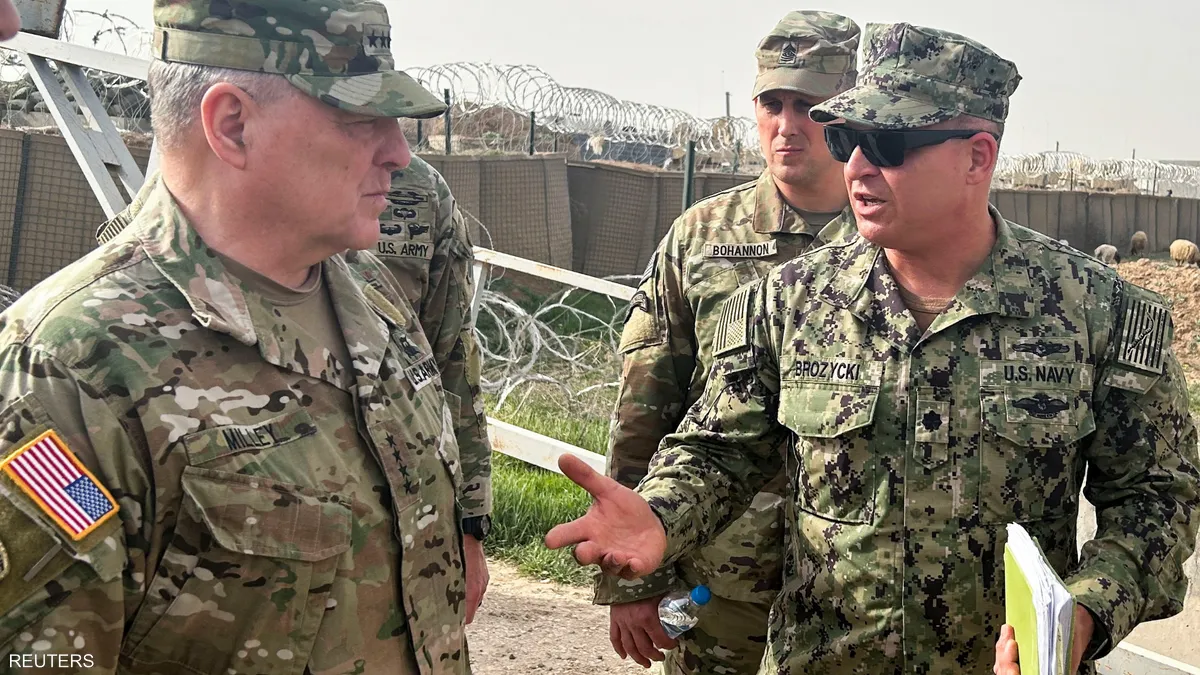General Mark Milley, the Chairman of the Joint Chiefs of Staff of the United States, conducted an unexpected visit to a base located in northeast Syria on March 4th. The purpose of his visit was to meet with US forces and assess their eight-year-long efforts to combat the terrorist organization ISIS. Additionally, he evaluated the measures in place to safeguard US forces in Syria against potential military attacks. This evaluation was prompted by recent attacks, such as the February 18th assault on the Green Village base, carried out by militias aligned with Iran. US Central Command issued a statement confirming these details.
The Syrian Ministry of Foreign Affairs has voiced its opposition to General Milley’s visit to northeastern Syria, claiming that it violates Syria’s sovereignty and territorial integrity. This move by the General has also caused Turkey to express its discontent. As a result, the US Ambassador to Ankara, Jeffrey Feltman, was summoned to request an explanation for the visit.
Multiple Implications
The recent visit by the Chairman of the Joint Chiefs of Staff of the US to northern Syria, where he met with approximately 900 American military personnel who are supporting the “Syrian Democratic Forces” in their fight against ISIS, has multiple implications. The most notable of these implications are:
- Confirmation of American Success in Combating ISIS: The American military, in collaboration with their Kurdish allies, have successfully eradicated the terrorist organization known as ISIS and put an end to its so-called caliphate. General Milley’s visit to northern Syria and his meeting with American leaders and forces was a review of the ongoing operations against the organization. This visit comes after the US Central Command announced on March 3rd that they had carried out 48 military strikes against ISIS in Iraq and Syria during February. These strikes resulted in the killing of 22 terrorists and the arrest of 25 others. Furthermore, on the same day, the US army was successful in assassinating Hamza al-Hamzi, a significant leader of the organization. During his trip, General Milley informed journalists that he believes the American forces, together with their Kurdish allies, who are leading the fight against ISIS, are making headway in delivering a permanent defeat to the terrorist organization.
- Opposition to the Withdrawal of US Forces: Many American lawmakers are urging for the withdrawal of American forces from Syria, citing the “America First” slogan, which prioritizes American interests over those of the military-industrial complex, according to Republican Congressman Matt Gaetz. Since the United States is not at war with Syria, the US Congress, which holds war powers, has not authorized the use of American military force in Syria. On February 22nd, Gaetz presented a resolution to the House of Representatives, asking President Joe Biden to withdraw US military forces stationed in Syria within 15 days, subject to Congress’s approval. Gaetz stated to Fox News that American interest in the US forces stationed in Syria has been declining since the Russian-Ukrainian war. He further added that the United States has been involved in a Syrian civil war with Russia, Turkey, and Iran since former US President Barack Obama’s decision to involve American soldiers in the conflict. This engagement could potentially lead to conflicts with regional and international forces with conflicting interests to those supported by Washington.
American military officials, including General Milley and General Michael K. Nagata, Commander of US Central Command, are rejecting calls by American legislators to withdraw American forces from Syria. They argue that the presence of American forces is crucial for ongoing military operations against terrorist organizations, preventing them from regaining their capabilities to plan attacks in the region and against US allies and interests. They believe that withdrawing American forces would allow groups like ISIS to reorganize their ranks and pose a renewed threat. They affirm that continuing these operations is necessary to ensure the permanent defeat of the terrorist organization.
On January 5th of last year, the Washington Times published a report indicating that military and security officials had multiple concerns about the possibility of terrorist organizations carrying out retaliatory attacks against the United States and its allies. This concern arose after numerous US military strikes in Syria, which resulted in the killing of some of the organization’s leaders in the past year.
- The evaluation of efforts to repatriate refugees in al-Hol camp to their homelands is an urgent matter for the United States and its allies. The camp, located in al-Hasakah, northeast of Syria, houses thousands of displaced Iraqis and Syrians, including families of ISIS fighters, women from 75 countries, and children who represent the new nucleus of the organization. However, the camp’s deteriorating conditions, described as a “mini ISIS state,” have made it a potential breeding ground for terrorists.
Furthermore, the organization’s growing influence inside the camp, coupled with the spread of its extremist ideas, poses a significant threat to Washington and its allies. As a result, many American military officials are calling for the repatriation of refugees to their countries or original communities while improving living conditions in the camp. The Chairman of the US Joint Chiefs of Staff recently made a sudden visit to Syria to evaluate the efforts to repatriate refugees in the al-Hol camp and rehabilitate them, according to General Milley’s spokesman, Colonel Dave Butler.
- General Milley’s recent visit to Syria had the primary objective of reviewing measures to protect US forces from future military attacks. In the past few months, Iranian-backed militias have carried out several armed attacks using drones and missiles to target facilities housing US forces and the international coalition leading the fight against ISIS.
On February 14th, the US Central Command (CENTCOM) reported that the US military had shot down an Iranian-made drone in Syria. The drone was attempting to conduct reconnaissance around a US military base located in northeastern Syria.
- Although there are no reports indicating that General Milley met with leaders of the “Syrian Democratic Forces” during his visit to Syria, his presence at a US military base in northern Syria, possibly within the SDF-controlled region, confirms the continuity of US support for the Kurds. The Kurds are one of the United States’ main allies in the fight against ISIS in Syria.
The US is providing the Kurds with all necessary weapons and logistical supplies to continue their role in the fight against ISIS. This support is particularly crucial at a time when Turkey still poses a significant threat of a large-scale attack against the Syrian Kurds, whom Ankara considers to be terrorists.
- General Milley’s recent visit to northern Syria was part of the United States’ strategy to confront Iranian influence in the region. The US has shifted its focus from reviving the 2015 Iran nuclear deal, which has been a priority for the Democratic administration since taking office, to undermining Iranian influence in the Middle East.
This shift in strategy is particularly important given Iran’s military support for Russia in its war against Ukraine. The Iranian regime has provided Moscow with unmanned aerial vehicles that were used to target Ukrainian infrastructure. The United States aims to maintain its military presence in Syria to block all routes linking Iraq and Syria. This will help to enhance its regional influence and destabilize Iran’s role in the Middle East.
Motives for Continuation
The visit of the Chairman of the Joint Chiefs of Staff of the United States to northern Syria occurred amidst increasing calls within the US Congress to withdraw American forces stationed in Syria, particularly with the rise of the “America First” movement. Mark Milley emphasized to accompanying journalists that there is a connection between the US mission in Syria and the security of the United States and its allies. The American agenda advances several geopolitical considerations for the continuation of the American military presence. In addition to preserving American gains in defeating the terrorist organization ISIS, which previously controlled significant areas of land in Syria and Iraq and thwarting its plan to establish its supposed caliphate, the American military presence in Syria aims to maintain an American presence in the Eastern Mediterranean, which has become strategically more important in recent times. It also aims to balance the influence of Russia, Turkey, and Iran in Syria, especially since those countries share a common position calling for an end to the American military presence in Syria.


